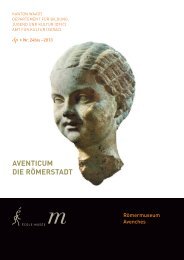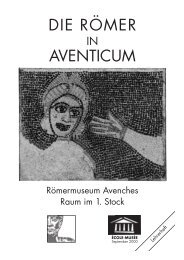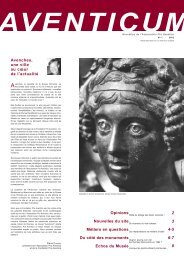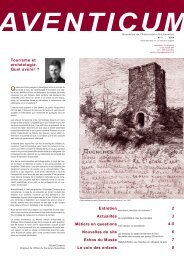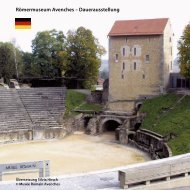Avenches – Roman Museum – Permanent Exhibition
Avenches – Roman Museum – Permanent Exhibition
Avenches – Roman Museum – Permanent Exhibition
Create successful ePaper yourself
Turn your PDF publications into a flip-book with our unique Google optimized e-Paper software.
First Floor Religion<br />
<strong>Roman</strong> Religion<br />
have enjoyed limited success in Gaul, the mystery cults of Cybele, Attis and Mithra<br />
attracted a great number of followers.<br />
Display case 19<br />
1. Jupiter Amon. Terra cotta oil lamp.<br />
2. Jupiter Amon, recognizable thanks to his ram’s horns. Decorative piece, bronze.<br />
3. Bronze votive hand dedicated to Sabazius (1). The hand shows a pinecone on the<br />
thumb, the bust of Sabazius on the inside of the hand between the index finger and the<br />
middle finger, and a bust of Mercury between the bent ring finger and the little finger.<br />
A twig is draped along the right outer side of the hand and the wrist is decorated with a<br />
small bell and a snake. On the exterior of the hand there is a bust of Cybele between the<br />
thumb and the index finger, a bust of Bacchus between the index finger and the middle<br />
finger and a ram’s head between the ring finger and the little finger. The back of the hand<br />
shows a lizard, a cantharos, a tortoise and a frog. A reclining woman holding a child is<br />
depicted at the lower end of the wrist. 1st <strong>–</strong> 2nd centuries AD.<br />
4. Ceramic vessel, probably from the cults of Sabazius or Mithra. There is a snake wrapped<br />
around each handle while lizards and tortoises are depicted on the body of the vessel.<br />
<strong>Roman</strong> Religion<br />
(Display cases 20-21)<br />
The <strong>Roman</strong>s worshipped many gods in public life as well as in private. Their religion<br />
was rather complicated, as it contained the old <strong>Roman</strong> cults as well as Greek and<br />
Etruscan elements, which are sometimes difficult to tell apart. Besides a multitude<br />
of secondary deities the main gods were Jupiter, Juno and Minerva, the Capitoline<br />
triad. Other popular gods were Mars, Venus, Apollo, Mercury and Bacchus.<br />
Religion and mythology in the provinces were not practised in the pure <strong>Roman</strong><br />
form. In fact, <strong>Roman</strong> and native deities merged. It is difficult to tell whether it was<br />
the <strong>Roman</strong>s who blended the native gods they encountered with their own deities,<br />
as did Julius Caesar in Gaul, or whether it was the vice versa.<br />
Some of the best examples of such blending can be found on inscriptions,<br />
which associate the name of a <strong>Roman</strong> god with that of a Gaulish deity like Mercury<br />
Cissonius (display case 24, no. 13), Mars Gradivus (display case 20, no. 13) or Mars<br />
Caisivus (display case 17, no. 6).<br />
Jupiter (display case 20, nos. 1-3 and display case 21) was the supreme deity.<br />
Caesar mentioned him as one of the five main gods of the Gauls. The Jupiter cult<br />
is well documented in this region thanks to inscriptions and numerous depictions.<br />
One of the most common representations shows him on horseback tearing across a<br />
defeated giant holding a flash of lightening in his hand. Such a statue, perched high<br />
up on a column, existed in Aventicum. Jupiter symbolised the victory of the sky god<br />
over the powers of the underworld.<br />
Mercury (display case 20, nos. 4-9, 14) was the patron of travellers and merchants<br />
and, for the Gauls, the inventor of all the arts. According to Julius Caesar he was<br />
1<br />
38<br />
First Floor<br />
19<br />
20<br />
21



